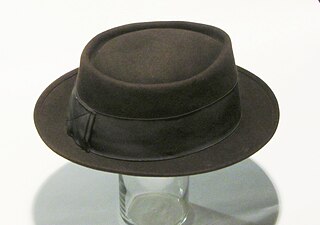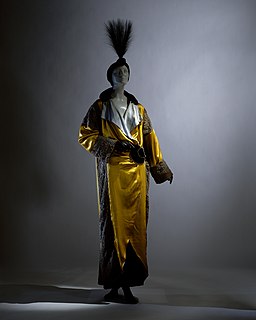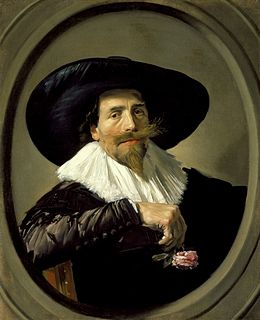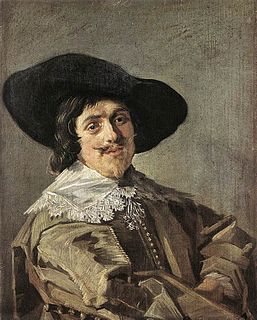
Max Ernst was a German painter, sculptor, printmaker, graphic artist, and poet. A prolific artist, Ernst was a primary pioneer of the Dada movement and Surrealism in Europe. He had no formal artistic training, but his experimental attitude toward the making of art resulted in his invention of frottage—a technique that uses pencil rubbings of textured objects and relief surfaces to create images—and grattage, an analogous technique in which paint is scraped across canvas to reveal the imprints of the objects placed beneath. Ernst is noted for his unconventional drawing methods as well as for creating novels and pamphlets using the method of collages. He served as a soldier for four years during World War I, and this experience left him shocked, traumatised and critical of the modern world. During World War II was designated an "undesirable foreigner" while living in France. He died in Paris on 1 April 1976.

Hat-making or millinery is the design, manufacture and sale of hats and other headwear. A person engaged in this trade is called a milliner or hatter.

The bowler hat, also known as a billycock, bob hat, bombín (Spanish) or derby, is a hard felt hat with a rounded crown, originally created by the London hat-makers Thomas and William Bowler in 1849. It has traditionally been worn with semi-formal and informal attire. The bowler, a protective and durable hat style, was popular with the British, Irish, and American working classes during the second half of the 19th century, and later with the middle and upper classes in the United Kingdom, Ireland, and the east coast of the United States.

A pork pie hat is one of several different styles of hat that have been popular since the mid-19th century. It features a flat crown that resembles a traditional pork pie.

A chemise or shift is a classic smock, or a modern type of women's undergarment or dress. Historically, a chemise was a simple garment worn next to the skin to protect clothing from sweat and body oils, the precursor to the modern shirts commonly worn in Western nations.

An opera cloak is an ankle- or floor-length loose-fitting cloak of dark, luxurious fabric such as velvet, brocade or satin, to be worn over an evening gown for a woman or a man's white tie or black tie tuxedo, named after its typical designation for the opera. It may be described as a fitted cloak, generally not as tailored as a coat. For white tie, men's opera cloaks are frequently worn with a walking stick and top hat.
Die Tat was a German monthly publication of politics and culture. It was founded in April 1909 and its publisher was Eugen Diederichs from Jena. From 1939 until 1944 Die Tat was continued as Das XX. Jahrhundert.
The kausia was an ancient Macedonian flat hat.

L'Absinthe is a painting by Edgar Degas, painted between 1875 and 1876. Its original title was Dans un Café, a name often used today.

Local regression or local polynomial regression, also known as moving regression, is a generalization of the moving average and polynomial regression. Its most common methods, initially developed for scatterplot smoothing, are LOESS and LOWESS, both pronounced. They are two strongly related non-parametric regression methods that combine multiple regression models in a k-nearest-neighbor-based meta-model. In some fields, LOESS is known and commonly referred to as Savitzky–Golay filter.

Switzerland competed at the 1936 Summer Olympics in Berlin, Germany. 190 competitors, 184 men and 6 women, took part in 100 events in 21 sports.

Drum hardware refers to the parts of a drum or drum kit that are used to tension, position, and otherwise support the instruments themselves.

An arakhchin is a traditional Armenian and Azerbaijani flat top skull cap headdress, worn by both men and women in the past.

Pieter Tjarck is a portrait painting by the Dutch Golden Age painter Frans Hals, painted in 1638 and now in the Los Angeles County Museum of Art, Los Angeles.

Portrait of a Man in a Yellowish-gray Jacket is an oil-on-panel portrait painting by the Dutch Golden Age painter Frans Hals, painted in 1633 and now in the Staatliche Kunstsammlungen Dresden, Dresden.

A lampshade hat is a millinery design in which the hat has a small circular crown – typically flat, but sometimes rounded – and flares outwards to create a cone-like profile. In shape, it may have some similarities to the pillbox and bucket hat, both of which were popular at around the same time, although the classic lampshade design is longer and more flared than a pillbox and is generally made of stiffer material than a bucket hat.

The tam is a millinery design for women based on the tam o' shanter military cap and the beret. Sometimes it is also known as a tam cap or the traditional term tam o'shanter might also be used. The tam became popular in the early 1920s, when it followed the prevailing trends for closer-fitting hats that suited shorter hairstyles and for borrowing from men's fashion; other traditional men's hats that rose to popularity in women's fashion during this period included the top hat and bowler. In the British Isles, the tam cap is often used as a headcovering by Christian women during church services.

Portrait of a Man is a c. 1657 portrait painting painted by Rembrandt. It is an oil on canvas and is in the collection of the Metropolitan Museum of Art.

"Mit Ernst, o Menschenkinder" is an Advent hymn by Valentin Thilo. It partly paraphrases the call to penitence by John the Baptist. The text was first published in 1642 in the collection Preußische Festlieder. The different melody that later became popular dates back to 1557.

















